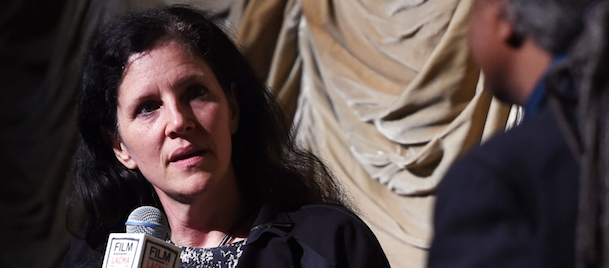CITIZENFOUR Director Laura Poitras Explains the Vision Behind Her Vérité Style

“I’m interested in what people do, not what they say.”
In her latest documentary, CITIZENFOUR, which had its West Coast premiere at Film Independent at LACMA last night, Laura Poitras trains her camera on what one idealistic 29-year-old did when he learned that the US government was conducting a covert campaign of tapping into the personal phone and internet records of millions of Americans without cause: he set off a global shit storm.
Before the public, before Wolf Blitzer, before even the POTUS himself learned that Edward Snowden was determined to blow the whistle, it was just three people in a Hong Kong hotel room: Snowden, reporter Glenn Greenwald and Poitras, who brought her camera.
It was a dramatic moment for Snowden, who had made the decision to leak classified documents, knowing that it would cost him his freedom—in one way or another. As the journalist chosen to break the story, Greenwald became a central character. Poitras simply let the camera roll.
“I try never to do interviews,” Poitras told Film Independent Curator Elvis Mitchell in the Q&A after the screening regarding the vision behind her vérité style. Citing the tradition of D.A. Pennebaker and Frederick Wiseman, Poitras said, “I want the camera to observe but not be a presence.“
Poitras’s decision to leave out Snowden’s backstory is another example of her just-let-it-happen ethos. “We learn a hell of a lot of who he is just because you’re in this moment of incredible high drama over a compressed period of time, and I’m interested in the things you learn in those moments about a person. That’s what I’m interested in in terms of understanding and building narratives.”
“Because I’m not asking a lot of questions,” she said. “I’m just watching and observing, you’re able to [capture] a kind of intimacy that’s different than if you are doing a one-to-one interview and someone’s responding.”
“Is it that you tend to look at these things as dramas first?” Mitchell asked, “rather than strictly-speaking issue-oriented pieces?”
“I’m interested in how people respond to things,” she said. “This film is about the dangers of NSA surveillance, but it’s really a film about courage, and people who are willing to risk things and take personal sacrifices because of something they believe in.”
It was during the making of her film Flag Wars when Poitras came to appreciate the power of patience. The film is a poignant look at a community in Columbus, Ohio undergoing gentrification when gay white home-buyers move into a working-class black neighborhood. “Flag Wars was my teacher as a filmmaker. We just spent a lot of time on the ground with people and just waited and sort of watched things unfold. And what I love to do most is just be there and film people and not interfere too much, and just let things unfold, and find situations in which people are confronted with some kind of conflict or decision-making and just be there and see the choices they make and what happens is the future is completely uncertain. You don’t actually know where this is leading, and contained in that is drama, and insight into human nature.”
“I’m using a cinematic language,” she explained. “I want to use scenes to build a sense of drama.”
“Reaction shots are powerful,” she said. “The person talking isn’t always the most interesting person. It’s oftentimes the person listening. When I shoot, I try to make sure I have a range of material to weave the story together. I’m interested in subtext. I’m interested in silence.”
Noting the Trent Reznor soundtrack as another example, Mitchell said, “You’re using fictional techniques to make the film work in really visceral ways.”
Pamela Miller / Website & Grants Manager